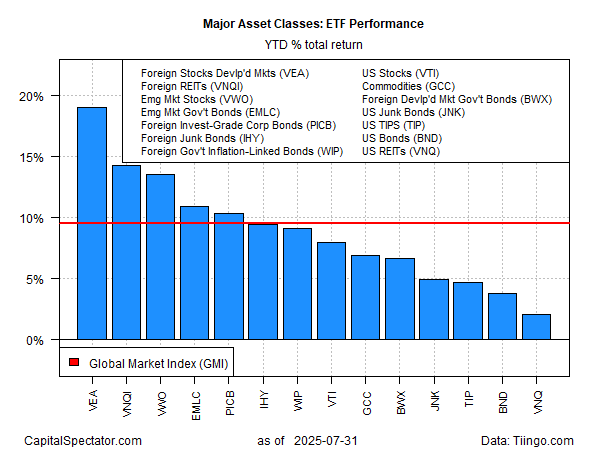Starbucks union plans Red Cup Day strike in 25+ cities - Bloomberg
President Trump on Thursday announced new tariffs on dozens of countries, marking a resumption of the trade-war policies that he originally outlined in April. Stocks fell around the world in reaction to the news, although all the major asset classes are still posting gains year to date, based on a set of ETFs through Thursday’s close (July 31). But with the return of an aggressive stance on trade from the White House, the near-term outlook for risk assets is again forced to price in the effects from erratic policy shifts.
As of yesterday’s 2025 performance data, the major market components around the world were posting gains across the board. The leading performer: developed-market stocks ex-US (VEA), which has rallied 19.1% so far this year. US shares (VTI), by comparison, are up a relatively moderately 8.0% in 2025. The Global Market Index (GMI), an unmanaged benchmark that holds all the major asset classes in market-value weights, is higher this year by nearly 10%.
The question now is how, or if, the return of a trade-war policies will affect markets? There’s certainly a lot of policy shift to digest, and so the near-term outlook will likely remain fluid.
For two of America’s largest trading partners – Mexico and Canada – sharply different rules apply. Mexico received a 90-day reprieve on new tariffs, allowing for negotiations to continue over the next three months. Canada, by contrast, is now subject to a hike in general tariffs to 35% from 25%.
By one estimate, Brazil has received the highest US tariff – 50%, according to analysis by the Financial Times. By contrast, the UK has the lowest tariff among America’s trading partners – a comparatively modest 10%.
The change in tariffs poses a new risk for the global economy, although economic activity has been relatively resilience in recent months following Trump’s initial announcement on tariffs in the spring. Investors will be closely watching how the latest update on US tariff policy affects expectations and incoming economic data.
“For the rest of the world, this is a serious demand shock,” Raghuram Rajan, former India central bank governor and chief economist of the International Monetary Fund, who is now a professor at the University of Chicago Booth School of Business, told Bloomberg TV today. “You will see a lot of central banks contemplating cutting as the rest of the world slows somewhat in the face of these tariffs.”
For the US, yesterday’s PCE inflation data for June hints at a possibility that pricing pressure is starting to creep higher. Prices rose 2.6% in June compared with a year ago, the Commerce Department said Thursday, edging up from an annual pace of 2.4% in May. Core PCE, which excludes the volatile food and energy categories, was steady at 2.8%.
“The Fed got validation [for leaving rates unchanged] this morning with inflation coming in a little higher than expected,” advised Scott Helfstein, head of investment strategy at Global X in an emailed comment. “There is some evidence of tariff impact in the inflation data, but it remains modest. Health care, housing and utilities continue to be key sources in driving inflation.”
The PCE inflation news was a factor in the latest pivot in Fed funds futures, which are now estimating a 61% probability that the central bank will leave its target rate unchanged at the next FOMC meeting in September. That compares with a modest estimate for a rate cut next month that had prevailed in recent days.
Perhaps the only certainty in the latest shift in tariff policy is that it’s expected to evolve further in the weeks and months ahead.
“Don’t assume this is the end of the story,” said Stephen Olson, Senior Visiting Fellow at ISEAS and a former US trade negotiator. “Trump regards this as an ongoing reality show. More ‘deals’ or further tariff increases are almost certain to follow. While we haven’t returned entirely to a ‘law of the jungle’ system, we have taken several huge strides back in that direction.”
